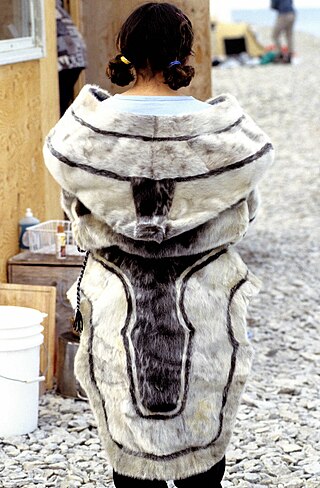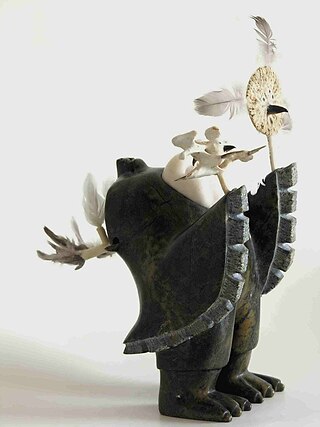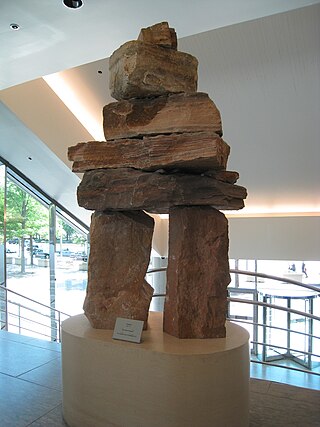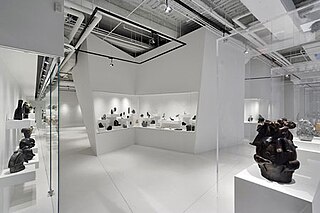Related Research Articles

Kitikmeot Region is an administrative region of Nunavut, Canada. It consists of the southern and eastern parts of Victoria Island with the adjacent part of the mainland as far as the Boothia Peninsula, together with King William Island and the southern portion of Prince of Wales Island. The regional centre is Cambridge Bay.

Jessie Oonark, was a prolific and influential Inuk artist of the Utkuhiksalingmiut Utkuhiksalingmiut whose wall hangings, prints and drawings are in major collections including the National Gallery of Canada.

The amauti is the parka worn by Inuit women of the eastern area of Northern Canada. Up until about two years of age, the child nestles against the mother's back in the amaut, the built-in baby pouch just below the hood. The pouch is large and comfortable for the baby. The mother can bring the child from back to front for breastfeeding or for eliminatory functions without exposure to the elements. This traditional eastern Arctic Inuit parka, designed to keep the child warm and safe from frostbite, wind and cold, also helps to develop bonding between mother and child.

The Netsilik (Netsilingmiut) are Inuit who live predominantly in Kugaaruk and Gjoa Haven, and somewhat in Taloyoak of the Kitikmeot Region, Nunavut, and, to a smaller extent in the north Qikiqtaaluk Region, in Canada. They were, in the early 20th century, among the last northern indigenous peoples to encounter missionaries from the south.

Inuit art, also known as Eskimo art, refers to artwork produced by Inuit, that is, the people of the Arctic previously known as Eskimos, a term that is now often considered offensive. Historically, their preferred medium was walrus ivory, but since the establishment of southern markets for Inuit art in 1945, prints and figurative works carved in relatively soft stone such as soapstone, serpentinite, or argillite have also become popular.
Shane Wilson is a sculptor who has lived and worked in Yukon and British Columbia, Canada. His principal mediums are antler, horn, ivory, and bronze, from which he creates sculpture in his signature style, a juxtaposition of abstract organic and non-organic shapes.
Floyd Kuptana (1964-2021) was an Inuvialuk (Inuit) artist in Canada whose work is primarily stone carvings as well as paintings and collage.

David Ruben Piqtoukun ᑎᕕᑎ ᐱᑐᑯ ᕈᐱᐃᓐ is an Inuvialuk (Inuit) artist from Paulatuk, Northwest Territories.
Andy Miki (1918–1982) was an Inuk artist from Arviat, Northwest Territories.

The Museum of Inuit Art, also known as MIA, was a museum in Toronto, Ontario, Canada located within the Queen's Quay Terminal at the Harbourfront Centre. It was devoted exclusively to Inuit art and culture.
Alain Paiement is a Canadian artist. His work is mainly made from photography in form of installations, sculptures, and photomontage. His themes are related to geography, topography and architecture and mainly concerned by the construction of vision. A photo of the French artist Pierre Estable's apartment titled "Living Chaos" has been exhibited at the Galerie Clark from May 10 to June 17, 2001.

Pitaloosie Saila was a Canadian Inuk graphic artist who predominantly made drawings and lithograph prints. Saila's work often explores themes such as family, shamanism, birds, and her personal life experiences as an Inuk woman. Her work has been displayed in over 150 exhibitions nationally and internationally, such as in the acclaimed Isumavut exhibition called "The Artistic Expression of Nine Cape Dorset Women". In 2004, Pitaloosie Saila and her well-known husband and sculptor Pauta Saila were both inducted into the Royal Canadian Academy of Arts.
Manasie Akpaliapik is a Canadian Inuk sculptor.

Ulayu Pingwartok was a Canadian Inuk artist known for drawings of domestic scenes and nature.

Karoo Ashevak was an Inuk sculptor who lived a nomadic hunting life in the Kitikmeot Region of the central Arctic before moving into Spence Bay, Northwest Territories in 1960. His career as an artist started in 1968 by participating in a government-funded carving program. Working with the primary medium of fossilized whale bone, Ashevak created approximately 250 sculptures in his lifetime, and explored themes of shamanism and Inuit spirituality through playful depictions of human figures, angakuit (shamans), spirits, and Arctic wildlife.

Mary Kapbak Okheena is an Inuvialuit graphic artist known for her stencil prints including "Musk-ox Waiting for the Tide to Cross Water" (1986) and "Shaman Dances to Northern Lights" (1991), drawings and embroidery. She is part of the third generation of organized graphic artists in the Canadian Arctic. Okheena has five children with her husband Eddie and she currently lives in Inuvik where she practices embroidery and makes wall hangings.

Kiugak Ashoona was a Canadian Inuk artist renowned for his sculptural work and his expansive artistic portfolio. He experienced the longest career of any Cape Dorset artist, and is a member of the Order of Canada and the Royal Canadian Academy of Arts. In 1999, he was awarded the Canada Council Molson Prize for his outstanding lifetime contribution to the cultural and intellectual life of Canada.
Abraham Anghik Ruben is an Inuvialuit Canadian sculptor of Yup'ik descent. Ruben was born south of the hamlet of Paulatuk in the Inuvik Region east of the Mackenzie River Delta in the Northwest Territories, Canada in 1951.
The West Baffin Eskimo Cooperative, also known as the Kinngait Co-operative is an Inuit co-operative in Kinngait, Nunavut best known for its activities in buying, producing and selling Inuit artworks. The co-operative is part of Arctic Co-operatives Limited, a group of locally owned businesses that provide fundamental services in the Canadian north. The co-operative sets prices for the sale of its member's works, pays the artists in advance and shares its profits with its members.
Mark Tungilik (1913?–1986) was an Inuit sculptor from Nunavut who specialized in miniature ivory carvings.
References
- 1 2 3 4 5 "Judas Ullulaq". www.gallery.ca. Retrieved 2020-03-01.
- 1 2 3 4 "Judas Ullulaq (Ooloolah) (1937-1999), Inuit artist biography and portfolio". Spirit Wrestler Gallery. Retrieved 2020-03-02.
- ↑ ProQuest 435761694
- 1 2 3 4 "Judas Ullulaq (Allulak)". FAMSF Search the Collections. 2018-09-21. Retrieved 2020-03-02.
- ↑ l’UQAM, Galerie de (2017-01-01). "1997 – Mother and Child by Judas Ullulaq". 150 years 150 works. Retrieved 2020-03-03.
- ↑ "Fisherman". www.gallery.ca. Retrieved 2020-03-03.
- ↑ "Judas Ullulaq Sculpture Breaks Record at Auction". Inuit Art Foundation. Retrieved 2020-03-03.
- ↑ 4
- ↑ "Mini-Masterworks III (Cross-cultural Group Exhibition) (October 24 - November 15, 2009)". Spirit Wrestler Gallery. Retrieved 2020-03-02.
- ↑ "Judas Ullulaq | Walrus | | Alaska on Madison". www.alaskaonmadison.com. Retrieved 2020-03-02.
- ↑ "Judas Ullulaq | Female shaman drummer with two helping spirits | 1979-1985 | Alaska on Madison". www.alaskaonmadison.com. Retrieved 2020-03-02.
- 1 2 "MutualArt.com - The Web's Largest Art Information Service". www.mutualart.com. Retrieved 2020-03-02.
- ↑ l’UQAM, Galerie de (2017-01-01). "Galerie de l'UQAM". 150 years 150 works. Retrieved 2020-03-02.
- ↑ "Search the Collection". www.gallery.ca. Retrieved 2020-03-02.
- ↑ "Judas Ullulaq | | | Alaska on Madison". www.alaskaonmadison.com. Retrieved 2020-03-02.
- ↑ Judas Ooloolah (Ullulaq): Gjoa Haven. Ottawa?: Canadian Arctic Producers Co-operative Ltd. 1987. OCLC 70525888.
- ↑ Foundation, Inuit Art. "Judas Ullulaq | Inuit Art Foundation | Artist Database". Inuit Art Foundation. Retrieved 2020-03-02.
- ↑ [WorldCat.org]. OCLC 43791113.